Paper crafting offers a serene escape from daily stress, allowing you to release your creativity while promoting relaxation and mindfulness. You'll find various easy DIY projects like origami, scrapbooking, and collage-making that can help reduce anxiety and improve your mental well-being. These crafts require simple tools and materials, making them accessible for beginners. As you engage in peaceful paper crafts, you'll enhance your fine motor skills, problem-solving abilities, and emotional expression. From folding delicate origami shapes to creating personalized greeting cards, these projects provide a calming outlet for self-expression. Discover how these gentle art forms can transform your leisure time into a therapeutic experience.
Benefits of Paper Crafting
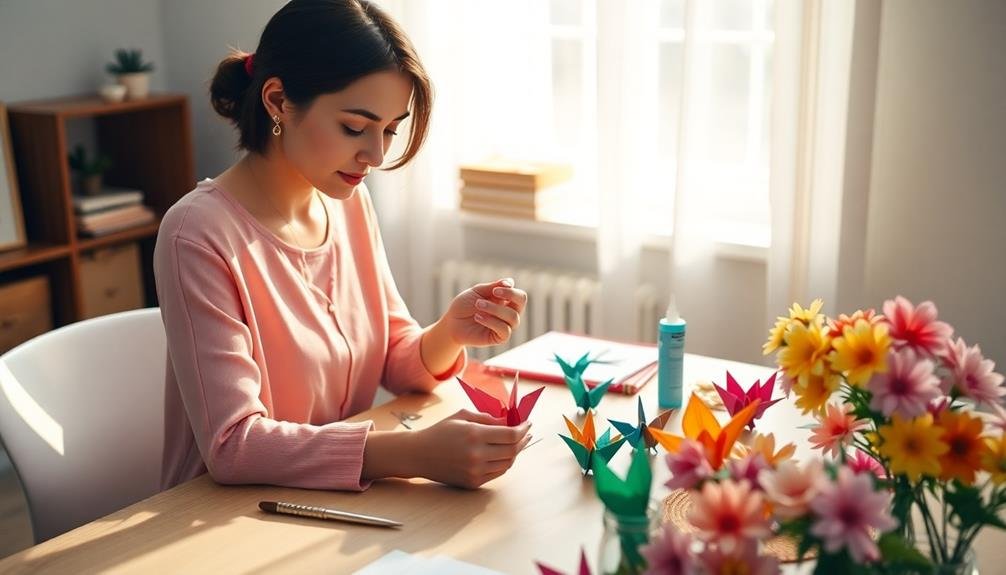
Despite its simplicity, paper crafting offers a wealth of benefits for both mind and body. When you engage in paper crafts, you'll experience reduced stress and anxiety as you focus on the task at hand, allowing your worries to fade away. This mindful activity promotes relaxation and can even lower your blood pressure.
You'll also boost your creativity and problem-solving skills as you work with different paper types, colors, and techniques. Paper crafting enhances your fine motor skills and hand-eye coordination, which can be particularly beneficial as you age. It's an excellent way to improve your concentration and memory, too.
Paper crafting is a cost-effective hobby that doesn't require expensive materials or tools. You can easily upcycle old papers and magazines, making it an eco-friendly pastime. It's also a versatile activity that you can enjoy alone or with others, fostering social connections and shared experiences.
Moreover, completing a paper craft project gives you a sense of accomplishment and boosts your self-esteem. You'll create tangible, beautiful objects that can be displayed, gifted, or used in everyday life, adding a personal touch to your surroundings.
Essential Tools and Materials
To get started with paper crafting, you'll need to gather the right tools and materials.
Begin by acquiring basic paper craft tools, exploring various paper types and textures, and selecting appropriate adhesives and embellishments.
These essentials will form the foundation of your paper crafting toolkit, enabling you to tackle a wide range of projects with confidence.
Basic Paper Craft Tools
Often, the most rewarding part of starting a new hobby is gathering the essential tools and materials. For paper crafting, you'll need a few basic items to get started. First, invest in a good pair of scissors. Look for ones with sharp blades and comfortable handles for precision cutting.
A paper trimmer is also invaluable for creating straight edges and consistent sizes. You'll want a reliable adhesive, such as a glue stick or double-sided tape, for joining paper pieces. A bone folder helps create crisp folds and smooth creases.
Don't forget a self-healing cutting mat to protect your work surface and extend the life of your blades. For more intricate designs, consider getting a craft knife with replaceable blades. Rulers and templates are essential for measuring and creating shapes.
A set of colored pencils or markers can add flair to your projects. Finally, stock up on different types of paper, including cardstock, origami paper, and patterned scrapbook paper. With these tools at your disposal, you'll be well-equipped to tackle a variety of paper craft projects and release your creativity.
Paper Types and Textures
Paper lies at the heart of every paper craft project, and understanding the various types and textures available can set you up for success. You'll encounter a wide range of options, each suited for different purposes.
Cardstock, a thicker and sturdier paper, is ideal for creating greeting cards, gift boxes, and structural elements in your crafts. It comes in various weights, typically ranging from 65 to 110 pounds.
For delicate projects like origami or intricate cut-outs, you'll want to use thinner papers like origami paper or tissue paper. These are more pliable and easier to fold or manipulate.
Textured papers, such as handmade or mulberry paper, add visual interest and tactile appeal to your creations. They're great for scrapbooking or as decorative elements.
Don't overlook specialty papers like vellum, which is semi-transparent and perfect for layering, or metallic papers that add a touch of sparkle.
Construction paper, with its vibrant colors, is excellent for children's crafts or bold, simple designs.
Adhesives and Embellishments
While choosing the right paper is key, your paper craft project's success also hinges on selecting appropriate adhesives and embellishments. For adhesives, opt for acid-free glue sticks or liquid glue for general paper bonding. Double-sided tape works well for precise applications, while hot glue guns are ideal for quick, strong bonds. Always consider the weight and texture of your paper when choosing an adhesive.
Embellishments add personality to your creations. Explore options like washi tape, which comes in various patterns and is easy to reposition. Stickers, sequins, and glitter can inject color and sparkle. For a natural touch, pressed flowers or leaves work beautifully. Ribbons and twine offer texture and can be used for hanging or binding.
Don't forget about stamps and ink pads for adding custom designs or text. Metallic pens and markers can create eye-catching accents. If you're feeling adventurous, try embossing powder with a heat gun for raised, shimmering effects.
Origami for Mindfulness
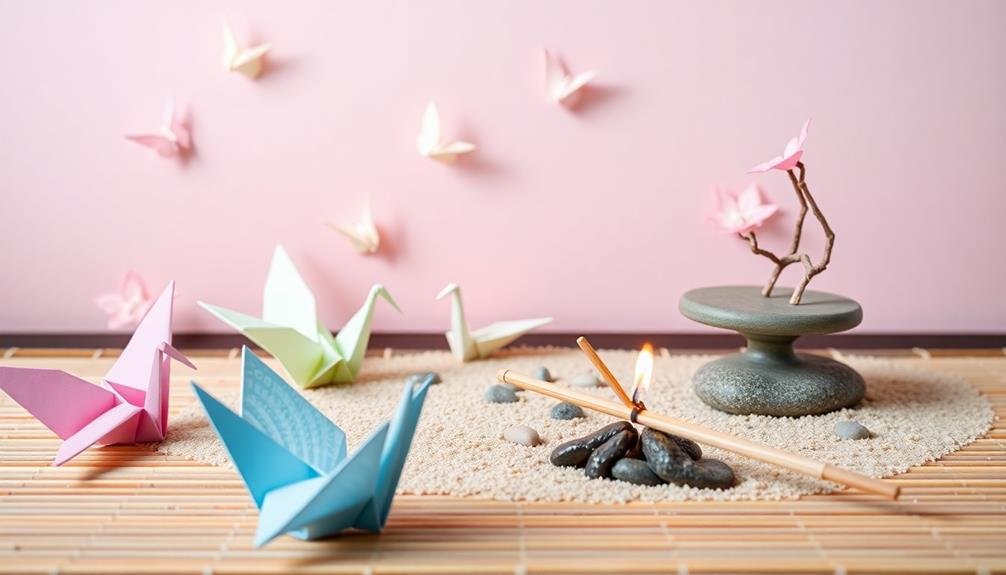
In your journey to explore origami for mindfulness, you'll discover how the art of paper folding can be a meditative practice.
You can start by learning mindful folding techniques that encourage focus and presence in the moment.
As you progress, you'll find simple origami designs that are perfect for beginners while still offering a calming and contemplative experience.
Mindful Folding Techniques
Origami, the Japanese art of paper folding, offers more than just beautiful creations. It's a powerful tool for mindfulness and relaxation. As you engage in mindful folding techniques, you'll find yourself fully present in the moment, focusing on each crease and fold.
To practice mindful origami, start by selecting a simple design. Breathe deeply and center yourself before beginning. As you fold, pay attention to the texture of the paper, the sound it makes, and the sensations in your fingers. Don't rush; take your time with each step.
Here's a guide to help you incorporate mindfulness into your origami practice:
| Technique | Description | Benefit |
|---|---|---|
| Breath awareness | Sync folding with breathing | Calms the mind |
| Gratitude folding | Express thankfulness with each fold | Cultivates positivity |
| Color meditation | Focus on paper's hue | Enhances concentration |
| Texture exploration | Notice paper's feel | Improves sensory awareness |
| Intention setting | Dedicate your creation | Adds meaning to practice |
Simple Origami Designs
Now that you're familiar with mindful folding techniques, let's explore some simple origami designs perfect for your mindfulness practice. These easy-to-create shapes can help you focus your attention and cultivate a sense of calm. Start with basic forms like the crane, lotus flower, or butterfly, which require just a few folds but yield beautiful results.
As you practice, remember to:
- Choose paper that feels pleasant to touch, enhancing your sensory experience
- Take your time with each fold, paying close attention to the paper's texture and your movements
- Breathe slowly and deliberately as you work, syncing your breath with your folding motions
Don't worry about achieving perfection; the process is more important than the end result.
As you become more comfortable with simpler designs, you can gradually progress to more complex patterns. Keep a collection of your finished origami pieces as a visual reminder of your mindfulness journey.
You'll find that creating these delicate paper sculptures can be a meditative experience in itself, allowing you to enter a state of flow and present-moment awareness.
Therapeutic Scrapbooking Techniques
Numerous individuals have discovered the therapeutic benefits of scrapbooking, making it more than just a creative hobby. It's a powerful tool for self-expression, stress relief, and preserving memories.
To get started, gather your supplies: photos, decorative paper, adhesives, and embellishments. Choose a theme or timeline for your scrapbook, such as a vacation or a year in review.
Begin by selecting and arranging your photos on a page. Don't be afraid to experiment with different layouts and compositions. Add journaling to provide context and personal reflections. This process can be particularly cathartic, allowing you to process emotions and gain new perspectives on past events.
Incorporate mindfulness techniques as you work. Focus on the textures of the materials, the colors you're using, and the memories associated with each element. This practice can help ground you in the present moment and reduce anxiety.
Consider creating a gratitude scrapbook, where you document things you're thankful for. This can be an excellent way to shift your focus towards positivity and improve your overall well-being.
Creating Calming Paper Collages
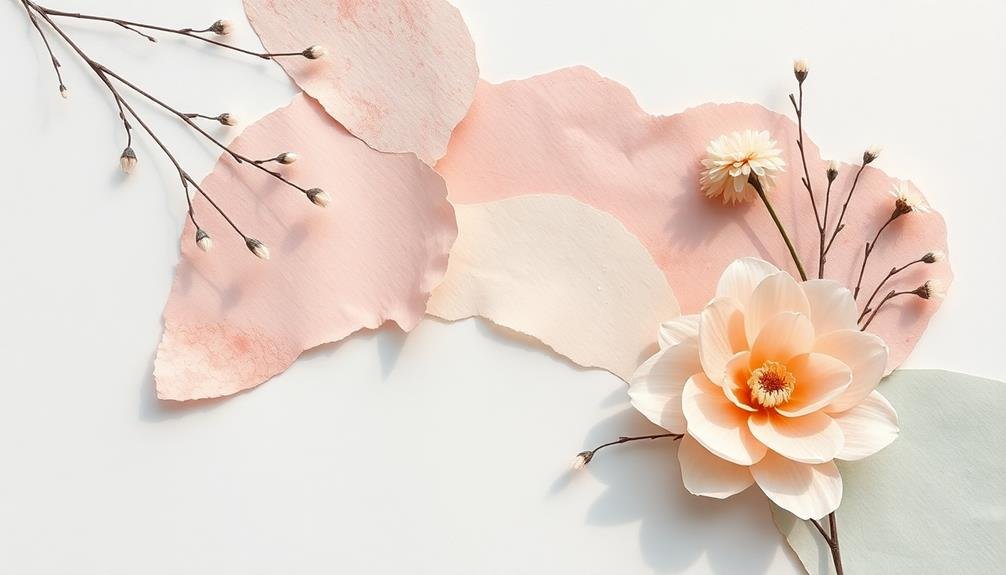
To create calming paper collages, you'll want to start by gathering soothing color palettes that resonate with your sense of tranquility.
As you build your collage, focus on mindfully layering different textures to add depth and interest to your piece.
Don't forget to incorporate meaningful symbols or images that hold personal significance, as these can enhance the emotional impact and therapeutic value of your collage.
Gather Soothing Color Palettes
Color selection is key when creating calming paper collages. You'll want to choose hues that evoke a sense of tranquility and relaxation. Soft pastels, muted earth tones, and cool blues and greens are excellent choices for a soothing palette.
Consider the emotional impact of colors and how they interact with each other to create a harmonious composition. When gathering your color palette, look for inspiration in nature, art, or even your favorite calming spaces. You can use colored paper, paint swatches, or even magazine clippings to curate your selection.
Don't be afraid to experiment with different shades and tones within your chosen color family.
To create a well-balanced and calming color palette:
- Choose a dominant color that sets the overall mood
- Select complementary colors that enhance the main hue
- Add neutral tones to balance and soften the composition
Layering Textures Mindfully
When creating calming paper collages, layering textures mindfully can add depth and interest to your composition. Start by selecting a variety of paper types with different textures, such as smooth cardstock, textured handmade paper, and delicate tissue paper. Reflect on how these textures will interact visually and tactilely when combined.
Begin with a base layer of sturdy paper or cardstock. Gradually build up your collage by adding layers of varying opacity and texture. Use thinner, more translucent papers to create subtle effects, allowing underlying layers to show through. Incorporate heavier, more textured papers for focal points or areas of emphasis.
Experiment with tearing, cutting, and folding techniques to create additional texture within your collage. Crumple tissue paper for a soft, cloud-like effect, or use a paper punch to create intricate patterns.
Don't forget to take into account the tactile experience of your collage; smooth areas can provide a sense of calm, while more textured elements can offer visual and sensory interest.
As you layer, step back periodically to assess the overall composition. Confirm that the textures complement each other and contribute to a harmonious, peaceful atmosphere in your paper craft.
Meaningful Symbol Integration
Symbols can add profound meaning to your calming paper collages. By incorporating symbols that resonate with you personally, you'll create a deeper connection to your artwork and enhance its relaxing effects. Choose symbols that represent peace, tranquility, or personal growth to infuse your collage with intentional energy.
When selecting and integrating meaningful symbols, consider these approaches:
- Research ancient symbols: Explore symbols from various cultures, such as the mandala, yin-yang, or tree of life. These time-honored designs often carry universal meanings of balance and harmony.
- Create personal symbols: Develop your own symbols based on experiences or aspirations. A simple shape or pattern can become a powerful representation of your journey.
- Use nature-inspired symbols: Incorporate elements like leaves, waves, or celestial bodies to evoke a sense of connection to the natural world.
As you work with these symbols, let your intuition guide you. Arrange them thoughtfully within your collage, allowing them to interact with other elements.
You'll find that integrating meaningful symbols not only enhances the visual appeal of your paper craft but also deepens its emotional impact, making your creative process more meditative and fulfilling.
Stress-Relieving Paper Quilling Projects
Paper quilling offers a soothing and meditative crafting experience that's perfect for stress relief. This intricate art form involves rolling, shaping, and gluing thin strips of paper to create decorative designs. To get started, you'll need quilling paper, a slotted tool, and glue.
Begin with simple shapes like circles and teardrops, gradually progressing to more complex forms as you gain confidence.
Try creating a calming mandala design by arranging various quilled shapes in a circular pattern. The repetitive nature of this project can help quiet your mind and reduce anxiety.
Another relaxing option is crafting a miniature landscape scene, using quilled elements to represent trees, flowers, and clouds. This allows you to focus on the present moment and escape everyday stressors.
For a quick stress-busting project, make quilled greeting cards. The act of rolling paper and forming delicate shapes can be incredibly therapeutic.
As you work, pay attention to the texture of the paper and the gentle movements of your hands. Remember, the goal isn't perfection but rather the peaceful process of creation.
Meditative Paper Cutting Art
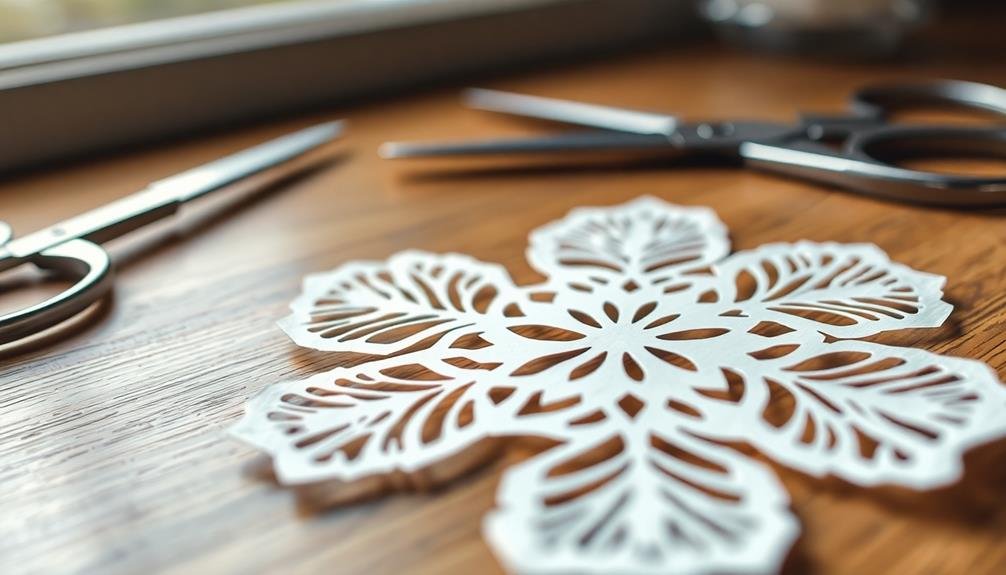
Scissors glide through paper, creating intricate patterns in the mesmerizing art of meditative paper cutting. This ancient technique, originating in China, has evolved into a modern stress-relieving practice. As you focus on carefully cutting delicate designs, you'll find your mind clearing and tension melting away.
To begin your paper cutting journey, you'll need:
- Sharp, precise scissors or a craft knife
- High-quality paper in various colors and weights
- A cutting mat to protect your work surface
Start with simple patterns and gradually progress to more complex designs. You can find templates online or create your own. As you cut, maintain a steady hand and breathe deeply, allowing the repetitive motions to lull you into a meditative state.
Paper cutting art isn't just relaxing; it's also a versatile craft. You can use your creations to decorate cards, make unique wall art, or even create 3D sculptures.
Don't worry about perfection – embrace the process and let your creativity flow. With practice, you'll develop your skills and discover the calming power of this beautiful art form.
Relaxing Handmade Card Ideas
Crafting handmade cards from out of your own creativity can be a soothing and rewarding experience. It's a simple yet effective way to unwind while creating something meaningful for others. To get started, gather basic supplies like cardstock, colored paper, scissors, and adhesives.
Begin with a simple design, such as a folded card with a decorative front. You can use techniques like paper quilling, where you roll thin strips of paper into coils and shapes, to create intricate designs.
Another relaxing method is watercolor painting, which allows you to blend soft colors for a calming effect. For a tactile experience, try embossing. Use embossing powder and a heat tool to create raised designs on your cards.
Alternatively, experiment with origami folding techniques to add dimension to your creations. Don't forget the power of words. Practice calligraphy or hand-lettering to add personalized messages. You can also use stamps or stencils for consistent designs.
Journaling With Paper Embellishments
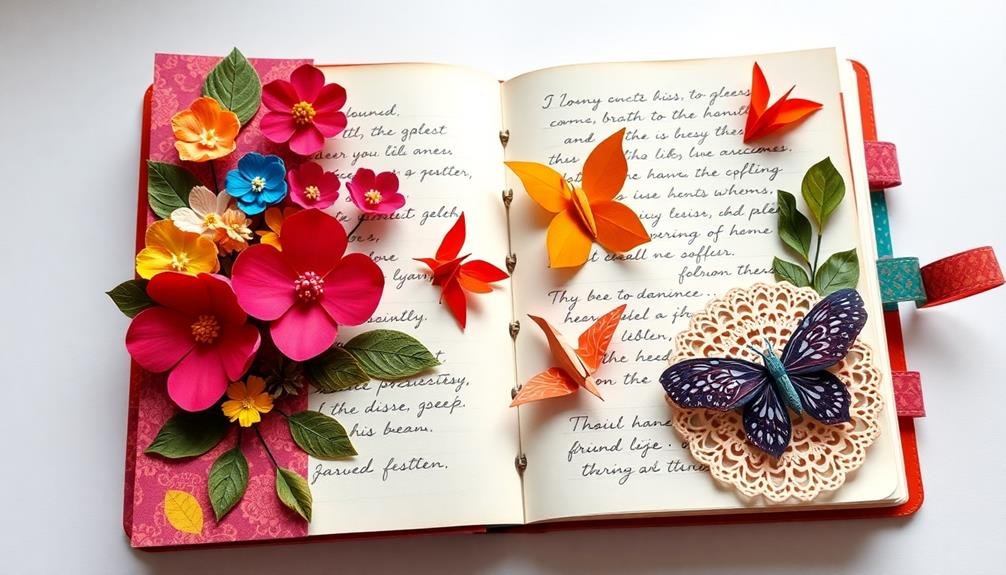
Creativity flourishes when you enhance your journaling with paper embellishments. These decorative elements add texture, depth, and visual interest to your pages, transforming your journal into a personal work of art.
You'll find that incorporating paper embellishments can make your journaling experience more enjoyable and expressive.
To get started, gather a variety of paper materials such as washi tape, stickers, and patterned paper. Experiment with layering different textures and colors to create unique backgrounds for your entries.
Don't be afraid to mix and match styles – the goal is to reflect your personality and mood.
Here are three simple ways to incorporate paper embellishments into your journal:
- Create pocket pages using origami techniques to store mementos
- Use paper punch-outs to frame important quotes or dates
- Design custom tabs with decorative paper for easy navigation
As you become more comfortable with paper embellishments, you'll discover endless possibilities for personalizing your journal.
This creative process can be incredibly relaxing and therapeutic, allowing you to express yourself while creating a beautiful keepsake of your thoughts and experiences.
Breathing Exercises While Crafting
Mindfulness can enhance your paper crafting experience, and incorporating breathing exercises is a great way to achieve this. As you work on your paper projects, try integrating simple breathing techniques to stay present and relaxed.
Start with deep belly breathing: Inhale slowly through your nose for a count of four, feeling your abdomen expand. Hold for a moment, then exhale through your mouth for a count of six. Repeat this cycle a few times before you begin crafting.
While cutting or folding paper, synchronize your breath with your movements. Inhale as you prepare to make a cut or fold, and exhale as you complete the action. This practice helps maintain focus and steady hands.
If you're feeling stressed or frustrated with a project, pause and try the 4-7-8 technique: Inhale for four counts, hold for seven, and exhale for eight. This can quickly calm your nervous system and reset your mood.
Remember to take occasional breaks during longer crafting sessions. Use these moments to stand up, stretch, and take a few deep breaths to refresh your mind and body.
Frequently Asked Questions
Can Paper Crafting Help With Anxiety Disorders?
Yes, paper crafting can help with anxiety disorders. You'll find it's a calming, focused activity that reduces stress. It engages your hands and mind, promoting mindfulness. You're creating something tangible, which can boost your self-esteem and confidence.
Are There Any Eco-Friendly Alternatives to Traditional Paper for Crafting?
You'll find several eco-friendly alternatives for crafting. Try recycled paper, bamboo paper, or handmade paper made from plant fibers. You can also use seed paper, which you can plant after use. These options reduce environmental impact.
How Can I Involve Children in Peaceful Paper Crafting Activities?
You can involve children in peaceful paper crafting by starting with simple projects like origami or paper airplanes. Encourage their creativity, teach patience, and make it fun. Use child-safe materials and supervise younger kids during crafting sessions.
What Are Some Cultural Significance of Paper Crafts Around the World?
You'll find paper crafts hold deep cultural significance worldwide. In Japan, origami symbolizes peace and good fortune. Chinese paper cutting represents happiness and prosperity. Mexican papel picado celebrates festivals. European quilling adorns religious artifacts. Each culture cherishes its unique paper traditions.
Can Paper Crafting Be Incorporated Into Art Therapy Sessions?
You can definitely incorporate paper crafting into art therapy sessions. It's a versatile medium that allows for self-expression, stress relief, and mindfulness. You'll find it helps clients process emotions, build confidence, and develop problem-solving skills through creative exploration.
In Summary
You've now explored a variety of peaceful paper crafts that can help you unwind and relax. Whether you're folding origami, creating collages, or journaling, remember that the process is more important than the result. Don't worry about perfection; focus on the calming motions and your breathing. Make these crafts a regular part of your self-care routine, and you'll find yourself feeling more centered and creative. Enjoy your crafting journey and the serenity it brings.

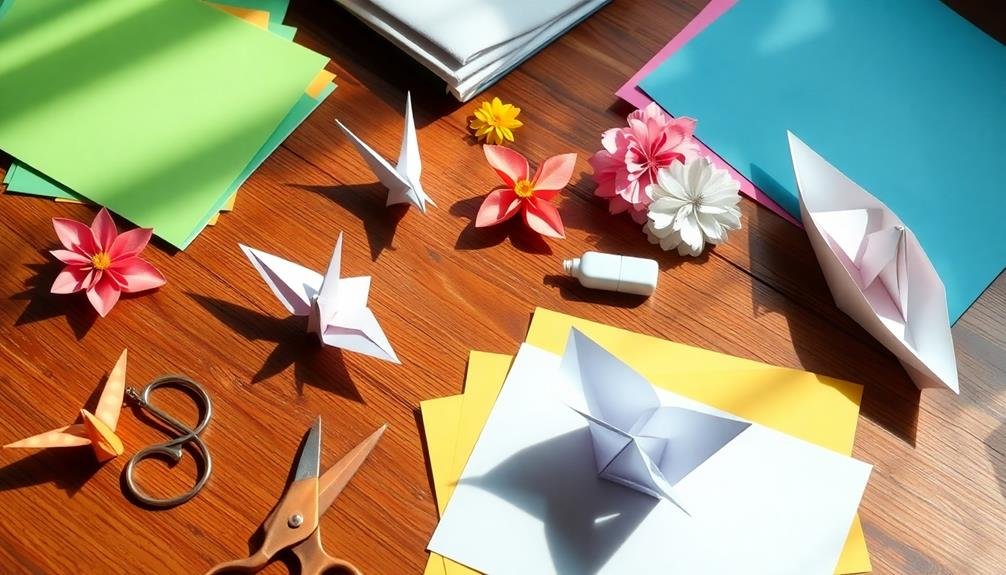



Leave a Reply